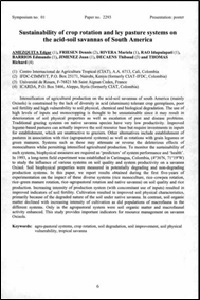Amelioration of degraded soils under red pine plantations on the Oak Ridges Moraine, Ontario
Soil degradation and subsequent amelioration were studied on soil chronosequences of old-growth forest, abandoned fields, and young and mature conifer plantations on the Oak Ridges Moraine, an environmentally vulnerable landform near Toronto threatened by encroaching urban development. The chronosequences reflect a history of pre-settlement deforestation, exploitive pioneer agriculture and ensuing land abandonment that led to soil fallowing and/or wind erosion in the 1920s followed by soil stabilization after extensive planting with red pine (Pinus resinosa Ait.).
Understanding global change: Lessons learnt from the European landscape
Europe is characterized not only by large geomorphological variability but also by a long history of land use. This resulted in a highly variegated landscape. Based on the IGBP‐transect initiative, a north south transect was established across Europe ranging from north Sweden to central Italy in order to study effects of global change. Mainly process oriented studies were established on plots along the transect, and these were used to establish functional relationships as basis for landscape integration.
Soil degradation in Kabd area, southwestern Kuwait City
Adverse environmental impacts of human activities are the main causes of soil degradation in the desert of Kuwait in general, and in Kabd area in particular. In this study, assessment of soil degradation in open and protected sites has been carried out using field measurements and laboratory investigations. The overall status of vegetation is nearly twice as low in vegetation cover in the open sites than in the protected ones due to overgrazing and off-road transport.
Farmland degradation in the mountains of Nepal: a study of watersheds ‘with’ and ‘without’ external intervention
Amidst growing concerns about farmlands conservation, this paper examines the status of farmlands in two mountain watersheds ‘with’ and ‘without’ external intervention, located in the western hills of Nepal. Information was obtained from a household survey and group discussions conducted during April to September 1999. The severity of soil erosion from farmers' perspectives, density of landslides, soil nutrient balance and change in crop yield have been adopted as indicators of the status of the land.
Unprotected Resources and Voracious World Markets
The Theory of the Second Best implies that any country with less-than-ideal resources can lose from international trade. Recently it has been suggested this means the South (poor countries) are better off suppressing trade with the North, especially trade in natural resource products, since the North has better developed rights to protect its natural resources. Here we show that the suppression of such trade may also impede the development of property rights in the South, but that even taking this into account, trade liberalization need not improve Southern welfare.
Forest ecosystem services: can they pay our way out of deforestation?
This paper first provides a brief overview of what are and what represent forest ecosystem services. Then it considers the issues of price and valuation, and shows that valuation itself is not a solution but merely a tool. Considering then the reasons of the overall degradation of forest ecosystem services it shows that the main reasons tend to be fundamental: deforestation most often happens because it pays for local people - not so much because the institutionally created arrangements are perverse.
Linkages between changes in land use land degradation and biodiversity. A preliminary investigation in S.W. Uganda. Part 1
Linkages between changes in land use land degradation and biodiversity. A preliminary investigation in S.W. Uganda. Part 2
Balancing agricultural development and deforestation in the Brazilian Amazon
Since the 1970s, federal policies promoting migration and encouraging agricultural development of large farms, logging, and ranching have led to the deforestation of vast areas of the Amazon rainforest.Though these policies have largely been replaced, deforestation continues. What effects do current macroeconomic and regional policies and events have on deforestation and on the well-being of settlers on the agricultural frontier?
Reaching sustainable food security for all by 2020
"As part of its 2020 Vision for Food, Agriculture, and the Environment Initiative, the International Food Policy Research Institute (IFPRI) has articulated a vision of what the world should look like in 2020: it should be a world free from poverty, hunger, malnutrition, and unsustainable natural resource management.







